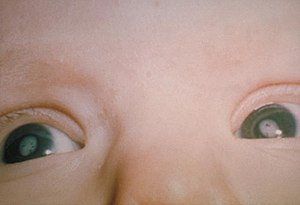Congenital rubella syndrome
| Congenital rubella syndrome | |
|---|---|
 |
|
| White pupils due to congenital cataract in a child with congenital rubella syndrome | |
| Classification and external resources | |
| Specialty | Teratology |
| ICD-10 | P35.0 |
| ICD-9-CM | 771.0 |
| DiseasesDB | 11729 |
| MedlinePlus | 001658 |
| eMedicine | emerg/388 |
| MeSH | D012410 |
Congenital rubella syndrome (CRS) can occur in a developing fetus of a pregnant woman who has contracted rubella, usually in the first trimester. If infection occurs 0–28 days before conception, the infant has a 43% risk of being affected. If the infection occurs 0–12 weeks after conception, the risk increases to 51%. If the infection occurs 13–26 weeks after conception, the risk is 23% of the infant being affected by the disease. Infants are not generally affected if rubella is contracted during the third trimester, or 26–40 weeks after conception. Problems rarely occur when rubella is contracted by the mother after 20 weeks of gestation and continues to disseminate the virus after birth.
It was discovered in 1941 by Australian Norman McAlister Gregg.
The molecular basis for the causation of congenital rubella syndrome are not yet completely clear, but in vitro studies with cell lines showed that rubella virus has an apoptotic effect on certain cell types. There is evidence for a p53-dependent mechanism.
The classic triad for congenital rubella syndrome is:
Other manifestations of CRS may include:
Children who have been exposed to rubella in the womb should also be watched closely as they age for any indication of:
Vaccinating the majority of the population is effective at preventing congenital rubella syndrome.
...
Wikipedia
